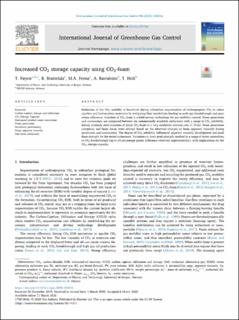| dc.contributor.author | Føyen, Tore Lyngås | |
| dc.contributor.author | Brattekås, Bergit | |
| dc.contributor.author | Fernø, Martin | |
| dc.contributor.author | Barrabino, Albert | |
| dc.contributor.author | Holt, Torleif | |
| dc.date.accessioned | 2020-10-28T09:52:42Z | |
| dc.date.available | 2020-10-28T09:52:42Z | |
| dc.date.created | 2020-08-12T11:08:14Z | |
| dc.date.issued | 2020 | |
| dc.identifier.issn | 1750-5836 | |
| dc.identifier.uri | https://hdl.handle.net/11250/2685447 | |
| dc.description.abstract | Reduction of the CO2 mobility is beneficial during subsurface sequestration of anthropogenic CO2 in saline aquifers and hydrocarbon reservoirs by mitigating flow instabilities leading to early gas breakthrough and poor sweep efficiency. Injection of CO2 foam is a field-proven technology for gas mobility control. Foam generation and coalescence are compared between six commercially available surfactants with a range in CO2 solubility, during unsteady state injection of dense CO2-foam in a long sandstone outcrop core (1.15 m). Foam generation categories and foam decay were defined based on the observed changes in foam apparent viscosity during generation and coalescence. The degree of CO2 solubility influenced apparent viscosity development and peak foam strength for the tested surfactants. Variations in foam peak strength resulted in a range of water saturations at CO2 breakthrough (up to 24 percentage points difference observed experimentally), with implications for the CO2 storage capacity. | en_US |
| dc.language.iso | eng | en_US |
| dc.publisher | Elsevier | en_US |
| dc.rights | Navngivelse 4.0 Internasjonal | * |
| dc.rights.uri | http://creativecommons.org/licenses/by/4.0/deed.no | * |
| dc.subject | Non-ionic surfactants | en_US |
| dc.subject | Foam apparent viscosity | en_US |
| dc.subject | Surfactant partitioning | en_US |
| dc.subject | Foam generation | en_US |
| dc.subject | Decreased residual water saturations | en_US |
| dc.subject | CO2 Storage Capacity | en_US |
| dc.subject | Carbon capture storage and utilization | en_US |
| dc.title | Increased CO2 storage capacity using CO2 -foam | en_US |
| dc.type | Peer reviewed | en_US |
| dc.type | Journal article | en_US |
| dc.description.version | publishedVersion | en_US |
| dc.rights.holder | © 2020 The Authors. Published by Elsevier Ltd. This is an open access article under the CC BY license (http://creativecommons.org/licenses/BY/4.0/). | en_US |
| dc.source.pagenumber | 11 | en_US |
| dc.source.volume | 96 | en_US |
| dc.source.journal | International Journal of Greenhouse Gas Control | en_US |
| dc.identifier.doi | https://doi.org/10.1016/j.ijggc.2020.103016 | |
| dc.identifier.cristin | 1822936 | |
| dc.relation.project | Norges forskningsråd: 267859 | en_US |
| dc.relation.project | Norges forskningsråd: 280341 | en_US |
| dc.relation.project | Norges forskningsråd: 268216 | en_US |
| dc.source.articlenumber | 103016 | en_US |
| cristin.ispublished | true | |
| cristin.fulltext | original | |
| cristin.qualitycode | 1 | |

